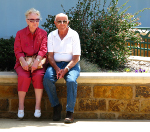Adressing Elderly Staircase Safety
Published by Stephen on October 5, 2009 Under fall prevention As a senior, it is not uncommon to move a little slower, both in regards to actual movements, as well as how quickly information is processed. This is actually a normal part of the aging process, but there are also a number of diseases, like arthritis, which are also common with age and can compound these problems. As a result of both the normal aging process, as well as diseases and conditions that are more common among the elderly, using the stairs can present some very big dangers for a senior.
As a senior, it is not uncommon to move a little slower, both in regards to actual movements, as well as how quickly information is processed. This is actually a normal part of the aging process, but there are also a number of diseases, like arthritis, which are also common with age and can compound these problems. As a result of both the normal aging process, as well as diseases and conditions that are more common among the elderly, using the stairs can present some very big dangers for a senior.
Why the Stairs Are So Dangerous
The stairs are, in fact, so dangerous that each year staircase falls represent the leading cause of hospitalization and accidental death of those who are over 65. This in part relates to another recent study that found that seniors who experienced a serious injury, such as a broken hip or fractured knee, were not only much more likely to no longer be able to live independently, but also a significant percentage of seniors would not live for another year after the incident. So, preventing these types of accidents is very important.
Falls on the stairs are made much more serious than other falls for several reasons. For one, the stairs are usually made of very hard materials and the edges of the steps are arranged in a manner that makes it hard to protect the body during a fall. So, when falling onto the steps, it is not uncommon to hurt several parts of the body, such as the wrist, hip, and knee, all at once. Also, since heights are also often involved, if the fall occurs at the top of the staircase, it is possible for the senior to fall all the way down the stairs, making the injuries even worse and more deadly.
Making the Staircase Safer
Since the stairs are such a dangerous place for seniors, it is important to make an effort to protect them from these dangers. One of the most important parts of staircase safety is ensuring the stairs are well lit and there is at least one secure handrail in place. The handrail should be made out of a smooth material, devoid of splinters, and small enough that the senior can easily fit their entire hand around it. Some studies have been preformed that indicate having dual handrails on the staircase, with one on either side, can also reduce the risk of a fall.
In regards to the lighting, it is important that the lights can be turned on from either side of the staircase, so there should be a light switch at both landings. This way, the person using the staircase must never walk up or down the stairs to turn on the light.
It is also very important that the staircase itself is kept free from clutter and in good repair. If the staircase is close to the front door, it is easy to get into the habit of setting items down on the stairs when you walk in the door. Often, these items end up staying there for awhile, which can greatly increase the risk of a tripping accident. Loose boards or uneven steps can also pose falling risks.
It is also important to remove any loose rugs from around the staircase, and for the rest of the home for that matter. This is because loose rugs could potentially slide when stepped on or fallen on, as well as having the edge of the rug turn up, creating a tripping hazard.
Thinking About the Seniors Abilities
While in many cases the condition of the stairs can and does directly affect the safety of the senior, it is also important to consider how well the senior can use the stairs.
For example, diseases like arthritis could make it much more difficult to raise the legs high enough to use the steps. Disease like glaucoma can make it difficult for the senior to see the steps as well.
If the senior is unable to safely use the stairs, than it may be a good idea to consider using a stair lift, which carries the senior up the stairs, or an elevator. The stair lift, however, is much less expensive and easier to install than an elevator. A third option would be to avoid the stairs whenever possible, but in most cases, this does not prove to be a acceptable solution.
No Comments |
Add a Comment